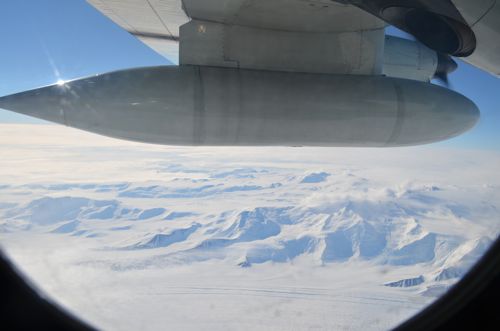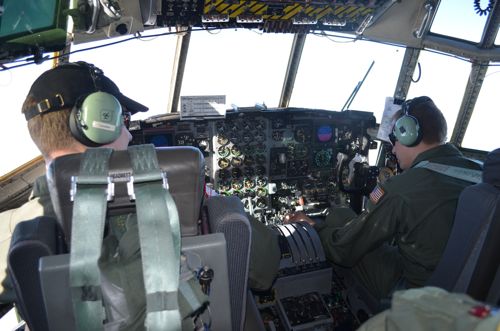Arriving at the Bottom of the World!
At 5:40 this morning, ten South Pole-bound travelers met at the post office building in McMurdo and took a van down to the ice runway. At the ice runway, we boarded the LC-13O plane, which is similar to the C-17 cargo plane I arrived on, but smaller and with skis on it!
 The LC-130 gets loaded with ECW gear and passengers heading to the South Pole.
The LC-130 gets loaded with ECW gear and passengers heading to the South Pole.
 People sleep and read inside the plane. The passengers near the end of the plane are some Norwegian dignitaries!
People sleep and read inside the plane. The passengers near the end of the plane are some Norwegian dignitaries!
When we boarded the plane, six Norwegian officials, including the Prime Minister of Norway, joined us. They were travelling to the pole to celebrate the 100th year anniversary of the first expedition to reach the South Pole. On December 14th, 1911, Norwegian explorer Roald Amundson and his team arrived at the pole.
The Icy Terrain Below
As we travelled 800 miles Southward, we passed over glaciers and rocky terrain. Eventually we flew over the Transantarctic Mountains. These mountains are the largest in Antarctica and separate East and West Antarctica. The Transantarctic Mountains stretch 3,500 kilometers across the continent and are one of the largest mountain ranges in the world. I was allowed to go up into the cockpit to get a great view of the mountains, as well as the Beardmore Glacier (where one of Scott's men died on his return from the pole). After the mountains, there was nothing but ice. The ice sheet, which the South Pole sits on top of, is roughly 2000 feet thick!
 Hundreds of miles of ice pass us on our way to the South Pole.
Hundreds of miles of ice pass us on our way to the South Pole.
 A view from inside the cockpit on the LC-130.
A view from inside the cockpit on the LC-130.
 The Transantarctic Mountains, as seen from the plane. Although they look small, they are covered in snow and are 12,000 feet high or so!
The Transantarctic Mountains, as seen from the plane. Although they look small, they are covered in snow and are 12,000 feet high or so!
Landing on the South Pole
Our plane landed smoothly, despite a fear from the pilots about poor weather conditions. Bob Melville, one of the engineers I will be working with at the AGO site, met me at the plane and I was ushered into an orientation. After lunch, Andy Stillinger, the other engineer who I will be working with, gave me a wonderful tour of the facilities including the famous Geographic and Ceremonial South Poles!
 Michelle Brown points to the Geographic South Pole. Note, this is the Geographic South Pole as measured in January of 2011.
Michelle Brown points to the Geographic South Pole. Note, this is the Geographic South Pole as measured in January of 2011.
 Michelle Brown stands at the accurate geographic South Pole, calculated for December 14, 2011.
Michelle Brown stands at the accurate geographic South Pole, calculated for December 14, 2011.
 Michelle Brown takes a picture of the Ceremonial South Pole.
Michelle Brown takes a picture of the Ceremonial South Pole.
Lucky Timing
It is incredible to be here. The snow crunches loudly beneath my feet and cold air stings my nose as I inhale some of the cleanest air in the world. I feel so lucky to stand at the bottom of the world! Best of all, I have not yet shown any symptoms of altitude sickness, which means I should be safe to travel to the AGO 4 site! We still don't know when we will leave for the AGO, since our cargo still hasn't arrived. I'm not complaining though--it looks like we will be at the South Pole for the 100th year anniversary!
Questions
Look at the pictures above of me at the Geographic South Pole and the marker that says South Pole, Dec 14, 2011. The actual geographic South Pole moves every year! Why would the South Pole keep moving? (Hint: Think about what the South Pole rests on).
There are many South Poles! There is the geographic South Pole, the Ceremonial South Pole, and more! Can you think of a South Pole that we are missing?
Math Connection
If the Transantarctic Mountain Ranges are 3,500 kilometers, how many miles long are they? (Hint: 1 mile = 1.62 kilometers).
If we traveled 800 miles from McMurdo Station to the South Pole in about 3 hours, how fast did we travel?
